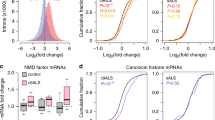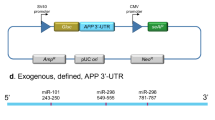Abstract
Amyloid precursor protein (APP) regulates neuronal synapse function, and its cleavage product Aβ is linked to Alzheimer's disease. Here, we present evidence that the RNA-binding proteins (RBPs) heterogeneous nuclear ribonucleoprotein (hnRNP) C and fragile X mental retardation protein (FMRP) associate with the same APP mRNA coding region element, and they influence APP translation competitively and in opposite directions. Silencing hnRNP C increased FMRP binding to APP mRNA and repressed APP translation, whereas silencing FMRP enhanced hnRNP C binding and promoted translation. Repression of APP translation was linked to colocalization of FMRP and tagged APP RNA within processing bodies; this colocalization was abrogated by hnRNP C overexpression or FMRP silencing. Our findings indicate that FMRP represses translation by recruiting APP mRNA to processing bodies, whereas hnRNP C promotes APP translation by displacing FMRP, thereby relieving the translational block.
This is a preview of subscription content, access via your institution
Access options
Subscribe to this journal
Receive 12 print issues and online access
$189.00 per year
only $15.75 per issue
Buy this article
- Purchase on Springer Link
- Instant access to full article PDF
Prices may be subject to local taxes which are calculated during checkout








Similar content being viewed by others

References
Torroja, L., Packard, M., Gorczyca, M., White, K. & Budnik, V. The Drosophila β-amyloid precursor protein homolog promotes synapse differentiation at the neuromuscular junction. J. Neurosci. 19, 7793–7803 (1999).
Mattson, M.P. Cellular actions of β-amyloid precursor protein and its soluble and fibrillogenic derivatives. Physiol. Rev. 77, 1081–1132 (1997).
Yang, G. et al. Reduced synaptic vesicle density and active zone size in mice lacking amyloid precursor protein (APP) and APP-like protein 2. Neurosci. Lett. 384, 66–71 (2005).
Rumble, B. et al. Amyloid A4 protein and its precursor in Down's syndrome and Alzheimer's disease. N. Engl. J. Med. 320, 1446–1452 (1989).
Hardy, J. & Selkoe, D.J. The amyloid hypothesis of Alzheimer's disease: progress and problems on the road to therapeutics. Science 297, 353–356 (2002).
Cohen, M.L., Golde, T.E., Usiak, M.F., Younkin, L.H. & Younkin, S.G. In situ hybridization of nucleus basalis neuron shows increased β-amyloid mRNA in Alzheimer's disease. Proc. Natl. Acad. Sci. USA 85, 1227–1231 (1988).
Higgins, G.A., Oyler, G.A., Neve, R.L., Chen, K.S. & Gage, F.H. Altered levels of amyloid protein precursor transcripts in the basal forebrain of behaviorally impaired aged rats. Proc. Natl. Acad. Sci. USA 87, 3032–3036 (1990).
Buckland, P. et al. Amyloid precursor protein mRNA levels in the mononuclear blood cells of Alzheimer's and Down's patients. Brain Res. Mol. Brain Res. 18, 316–320 (1993).
Theuns, J. et al. Promoter mutations that increase amyloid precursor-protein expression are associated with Alzheimer disease. Am. J. Hum. Genet. 78, 936–946 (2006).
Lv, H., Jia, L. & Jia, J. Promoter polymorphisms which modulate APP expression may increase susceptibility to Alzheimer's disease. Neurobiol. Aging 29, 194–202 (2008).
Wang, P.L., Niidome, T., Akaike, A., Kihara, T. & Sugimoto, H. Rac1 inhibition negatively regulates transcriptional activity of the amyloid precursor protein gene. J. Neurosci. Res. 87, 2105–2114 (2009).
Patel, N. et al. MicroRNAs can regulate human APP levels. Mol. Neurodegener. 3, 10 (2008).
Hébert, S.S. et al. MicroRNA regulation of Alzheimer's amyloid precursor protein expression. Neurobiol. Dis. 33, 422–428 (2009).
Rajagopalan, L.E., Westmark, C.J., Jarzembowski, J.A. & Malter, J.S. hnRNP C increases amyloid precursor protein (APP) production by stabilizing APP mRNA. Nucleic Acids Res. 26, 3418–3423 (1998).
Westmark, C.J. & Malter, J.S. Extracellular-regulated kinase controls β-amyloid precursor protein mRNA decay. Brain Res. Mol. Brain Res. 90, 193–201 (2001).
Rogers, J.T. et al. An iron-responsive element type II in the 5′-untranslated region of the Alzheimer's amyloid precursor protein transcript. J. Biol. Chem. 277, 45518–45528 (2002).
Beaudoin, M.E., Poirel, V.J. & Krushel, L.A. Regulating amyloid precursor protein synthesis through an internal ribosomal entry site. Nucleic Acids Res. 36, 6835–6847 (2008).
Westmark, C.J. & Malter, J.S. FMRP mediates mGluR5-dependent translation of amyloid precursor protein. PLoS Biol. 5, e52 (2007).
Orphanides, G. & Reinberg, D. A unified theory of gene expression. Cell 108, 439–451 (2002).
Moore, M.J. From birth to death: the complex lives of eukaryotic mRNAs. Science 309, 1514–1518 (2005).
Zalfa, F. et al. The fragile X syndrome protein FMRP associates with BC1 RNA and regulates the translation of specific mRNAs at synapses. Cell 112, 317–327 (2003).
Parker, R. & Sheth, U. P bodies and the control of mRNA translation and degradation. Mol. Cell 25, 635–646 (2007).
Barbee, S.A. et al. Staufen- and FMRP-containing neuronal RNPs are structurally and functionally related to somatic P bodies. Neuron 52, 997–1009 (2006).
Eulalio, A., Behm-Ansmant, I. & Izaurralde, E. P bodies: at the crossroads of post-transcriptional pathways. Nat. Rev. Mol. Cell Biol. 8, 9–22 (2007).
Balagopal, V. & Parker, R. Polysomes, P bodies and stress granules: states and fates of eukaryotic mRNAs. Curr. Opin. Cell Biol. 21, 403–408 (2009).
Chu, C.Y. & Rana, T.M. Translation repression in human cells by microRNA-induced gene silencing requires RCK/p54. PLoS Biol. 4, 1122–1136 (2008).
Fusco, D. et al. Single mRNA molecules demonstrate probabilistic movement in living mammalian cells. Curr. Biol. 13, 161–167 (2003).
Laggerbauer, B., Ostareck, D., Keidel, E.M., Ostareck-Lederer, A. & Fischer, U. Evidence that fragile X mental retardation protein is a negative regulator of translation. Hum. Mol. Genet. 10, 329–338 (2001).
Brown, V. et al. Microarray identification of FMRP-associated brain mRNAs and altered mRNA translational profiles in fragile X syndrome. Cell 107, 477–487 (2001).
Todd, P.K., Mack, K.J. & Malter, J.S. The fragile X mental retardation protein is required for type-I metabotropic glutamate receptor dependent translation of PSD-95. Proc. Natl. Acad. Sci. USA 100, 14374–14378 (2003).
Ceman, S. et al. Phosphorylation influences the translation state of FMRP-associated polyribosomes. Hum. Mol. Genet. 12, 3295–3305 (2003).
Zalfa, F., Achsel, T. & Bagni, C. mRNPs, polysomes or granules: FMRP in neuronal protein synthesis. Curr. Opin. Neurobiol. 16, 265–269 (2006).
Zukin, R.S., Richter, J.D. & Bagni, C. Signals, synapses, and synthesis: how new proteins control plasticity. Front. Neural Circuits 3, 14 (2009).
Caudy, A.A., Myers, M., Hannon, G.J. & Hammond, S.M. Fragile X-related protein and VIG associate with the RNA interference machinery. Genes Dev. 16, 2491–2496 (2002).
Ishizuka, A., Siomi, M.C. & Siomi, H. A Drosophila fragile X protein interacts with components of RNAi and ribosomal proteins. Genes Dev. 16, 2497–2508 (2002).
Jin, P., Alisch, R.S. & Warren, S.T. RNA and microRNAs in fragile X mental retardation. Nat. Cell Biol. 6, 1048–1053 (2004).
Jin, P. et al. Biochemical and genetic interaction between the fragile X mental retardation protein and the microRNA pathway. Nat. Neurosci. 7, 113–117 (2004).
Didiot, M.C., Subramanian, M., Flatter, E., Mandel, J.L. & Moine, H. Cells lacking the fragile X mental retardation protein (FMRP) have normal RISC activity but exhibit altered stress granule assembly. Mol. Biol. Cell 20, 428–437 (2009).
Zhao, X. et al. A 57-nucleotide upstream early polyadenylation element in human papillomavirus type 16 interacts with hFip1, CstF-64, hnRNP C1/C2, and polypyrimidine tract binding protein. J. Virol. 79, 4270–4288 (2005).
Schepens, B. et al. A role for hnRNP C1/C2 and Unr in internal initiation of translation during mitosis. EMBO J. 26, 158–169 (2007).
Ingelfinger, D., Arndt-Jovin, D.J., Lührmann, R. & Achsel, T. The human LSm1–7 proteins colocalize with the mRNA-degrading enzymes Dcp1/2 and Xrnl in distinct cytoplasmic foci. RNA 8, 1489–1501 (2002).
van Dijk, E. et al. Human Dcp2: a catalytically active mRNA decapping enzyme located in specific cytoplasmic structures. EMBO J. 21, 6915–6924 (2002).
Cougot, N., Babajko, S. & Séraphin, B. Cytoplasmic foci are sites of mRNA decay in human cells. J. Cell Biol. 165, 31–40 (2004).
Rajagopalan, L.E. & Malter, J.S. Growth factor-mediated stabilization of amyloid precursor protein mRNA is mediated by a conserved 29-nucleotide sequence in the 3′ untranslated region. J. Neurochem. 74, 52–59 (2000).
Abdelmohsen, K., Srikantan, S., Kuwano, Y. & Gorospe, M. miR-519 reduces cell proliferation by lowering RNA-binding protein HuR levels. Proc. Natl. Acad. Sci. USA 105, 20297–20302 (2008).
Abdelmohsen, K. et al. Phosphorylation of HuR by Chk2 regulates SIRT1 expression. Mol. Cell 25, 543–557 (2007).
Jensen, K.B. & Darnell, R.B. CLIP: crosslinking and immunoprecipitation of in vivo RNA targets of RNA-binding proteins. Methods Mol. Biol. 488, 85–98 (2008).
Kuwano, Y. et al. MKP-1 mRNA stabilization and translational control by RNA-binding proteins HuR and NF90. Mol. Cell. Biol. 28, 4562–4575 (2008).
Acknowledgements
We thank F.E. Indig and M.H. Dehoff for assistance with experiments. This research was supported by the National Institute on Aging-Intramural Research Program, US National Institutes of Health. P.F.W. is suppported by DA00266.
Author information
Authors and Affiliations
Contributions
E.K.L., H.H.K., K.A., J.L.M., X.Y., M.P.M. and M. Gorospe designed the study; E.K.L., H.H.K., Y. K., K.A., S.S., S.S.S., J.L.M. and X.Y. performed the experiments; E.K.L., Y. K., M. Gleichmann, M.R.M., X.Y., P.F.W. and M.P.M. contributed key reagents; E.K.L., M.P.M. and M. Gorospe wrote the paper.
Corresponding author
Ethics declarations
Competing interests
The authors declare no competing financial interests.
Supplementary information
Supplementary Text and Figures
Supplementary Figures 1–7 (PDF 2066 kb)
Rights and permissions
About this article
Cite this article
Lee, E., Kim, H., Kuwano, Y. et al. hnRNP C promotes APP translation by competing with FMRP for APP mRNA recruitment to P bodies. Nat Struct Mol Biol 17, 732–739 (2010). https://doi.org/10.1038/nsmb.1815
Received:
Accepted:
Published:
Issue Date:
DOI: https://doi.org/10.1038/nsmb.1815
This article is cited by
-
IGF2 is upregulated by its antisense RNA to potentiate pancreatic cancer progression
Functional & Integrative Genomics (2023)
-
Blockade of Type 2A Protein Phosphatase Signaling Attenuates Complement C1q-Mediated Microglial Phagocytosis of Glutamatergic Synapses Induced by Amyloid Fibrils
Molecular Neurobiology (2023)
-
The Roles of hnRNP Family in the Brain and Brain-Related Disorders
Molecular Neurobiology (2023)
-
LncRNA CEBPA-DT promotes liver cancer metastasis through DDR2/β-catenin activation via interacting with hnRNPC
Journal of Experimental & Clinical Cancer Research (2022)
-
lncRNA CYTOR promotes aberrant glycolysis and mitochondrial respiration via HNRNPC-mediated ZEB1 stabilization in oral squamous cell carcinoma
Cell Death & Disease (2022)


